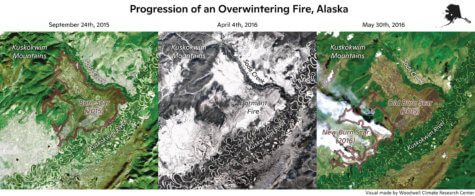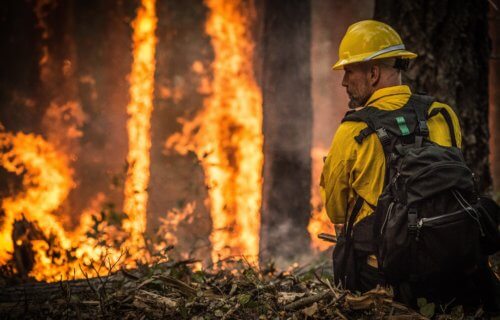AMSTERDAM, Netherlands — The thought of a zombie rising out of a grave is enough to frighten any rational person. Now, scientists say an even more unnerving phenomenon is starting to become a reality, wildfires springing to life out of the snow. A new study finds global warming is fueling “zombie forest fires” which can be nearly impossible to put out.
The phenomenon, which researchers call a “climate bomb,” can account for more than a third of burned trees. It is caused by “overwintering,” where embers continue to smolder under the snow and return from the dead the following spring. These embers are the remnants of the previous year’s fires and the study finds their numbers are on the rise.
“We expect more overwintering fires will occur with climate change. It seems they are here to stay,” says Rebecca Scholten, an Earth scientist at Vrije University in Amsterdam, in a statement to SWNS.
Scientists have dubbed these reincarnated blazes “zombie fires” because they’re incredibly difficult to extinguish – even in the harsh, wintry conditions of Alaska and Siberia.

How does a zombie fire rise from the grave?
The carbon-rich peat and decomposed spruce needles glow and smoke at least four inches underground. This enables the fires to survive rain, snow, and freezing temperatures before springing back to life when the weather improves.
This process sparks major grass fires in the spring and forest fires in summer. Last year, firefighters battled one in a wildlife reserve in Siberia that raged for months. The boreal forests of high-latitude regions have higher concentrations of carbon dioxide. They spew vast amounts of the greenhouse gas into the atmosphere as they burn.
CO2 emissions drive the heating of the planet, which in turn makes the impacts of the climate crisis more frequent and severe. Scholten and researchers charted the zombie fires systematically over almost two decades using satellite data. NASA images show they start along the borders of the old fires, where oxygen levels are low under the snow pack.
Forest fires in the northern hemisphere are a regular hazard and lightning can act as a natural spark. However, the study, appearing in the journal Nature, reveals overwintering is also becoming a common trigger.
“Another clue is they start before the lightning season – and far away from human activity,” Scholten explains. “They cover about one percent of the total burned area – with large variations between years. The worst are after hot summers. Warmer temperatures allow fires to burn deeper into the organic soil – which may help to sustain them over the winter.”
Earth is heating up in its coldest places
In 2015, these blazes accounted for 38 percent of the burned area in Alaska; that’s an area the size of Paris. That number has skyrocketed from the 22 percent devastated just five years earlier.
“Since 1975 summer temperatures have been rising in tandem with the burned area,” the study author continues.
The findings may have implications for fire management policies, by helping to identify and extinguishing zombie fires in advance.
“Boreal forests, despite their high latitudes, present favorable conditions for overwintering fires with deep organic soil and a warming climate,” Scholten tells SWNS. “But the extent of overwintering fires in these forests and their drivers have been unclear.”
The researchers developed an algorithm to identify them across Alaska, the U.S., and Canada from 2002 to 2018 using field and satellite data.
“As climate change increases temperatures they may become more common,” Scholten concludes. “Early detection and suppression of these fires could contribute to cost savings for fire management agencies.”
Last summer, wildfires in the Arctic Circle broke carbon emissions records. The region continues to deteriorate at a faster pace than the rest of the world. In June 2020, the city of Verkhoyansk, Russia hit 100 degrees Fahrenheit, an unprecedented milestone.
SWNS writer Mark Waghorn contributed to this report.
